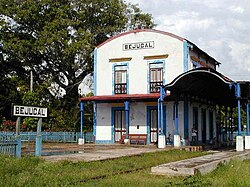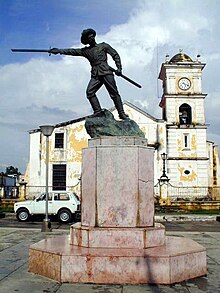Bejucal
Bejucal | |
|---|---|
 Bejucal railway station | |
 Bejucal municipality (red) within Mayabeque Province (yellow) and Cuba | |
| Coordinates: 22°55′58″N 82°23′13″W / 22.93278°N 82.38694°W | |
| Country | Cuba |
| Province | Mayabeque |
| Founded | 1874[1] |
| Area | |
• Total | 120 km2 (50 sq mi) |
| Elevation | 105 m (344 ft) |
| Population (2022)[3] | |
• Total | 28,205 |
| • Density | 240/km2 (610/sq mi) |
| Time zone | UTC-5 (EST) |
| Area code | +53-7 |
Bejucal is a municipality and town in the Mayabeque Province of Cuba. It was founded in 1713.[1] It is well known as the terminal station of the first railroad built in Cuba and Latin America in 1837. It also hosts one of the most popular and traditional carnival fest in Cuba: "Charangas de Bejucal". Bejucal has also been known as a telecommunications site, hosting broadcasts of several news and media networks.[4] It was also host to Soviet nuclear warheads during the Cuban Missile Crisis.[5] Bejucal also hosts a signals intelligence listening station operated by the People's Liberation Army Third Department of the Joint Staff Department.[6][7][8]
Geography
[edit]The municipality borders to the north with Boyeros (a municipal borough of Havana); to the east with San José de las Lajas; to the south with Quivicán; and on the west with San Antonio de los Baños.
It is divided into the barrios of Bejucal, Beltrán, Cuatro Caminos, Rancho Recreo, Buenaventura, Caguazo and Río Hondo.[1]
Demographics
[edit]In 2022, the municipality of Bejucal had a population of 28,205.[3] With a total area of 120 km2 (46 sq mi),[2] it has a population density of 240/km2 (620/sq mi).
Notable residents
[edit]Notable current and former residents of Bejucal include:
- Andy García, actor, was born and lived here until the age of five.
- Albio Sires, Member of the United States House of Representatives from New Jersey's 8th congressional district.[9]
- NJ Perez, author of highly acclaimed historical novels.
See also
[edit]
References
[edit]- ^ a b c Guije.com. "Bejucal" (in Spanish). Archived from the original on 12 October 2007. Retrieved 2007-10-07.
- ^ a b Statoids (July 2003). "Municipios of Cuba". Archived from the original on 12 October 2007. Retrieved 2007-10-07.
- ^ a b "Cuba: Administrative Division (Provinces and Municipalities) - Population Statistics, Charts and Map". www.citypopulation.de. Archived from the original on 2021-01-21. Retrieved 2024-02-03.
- ^ "Short-Wave Radio Frequency Schedule for site Bejucal". Archived from the original on 2022-11-24. Retrieved 2024-06-07.
- ^ Dobbs, Michael (2008). One minute to midnight : Kennedy, Khrushchev, and Castro on the brink of nuclear war (1 ed.). New York: Alfred A. Knopf. p. 109. ISBN 978-1-4000-4358-3. OCLC 176951842. Archived from the original on 2010-01-11. Retrieved 2024-06-07.
{{cite book}}: CS1 maint: date and year (link) - ^ "America and China try to move past a new bump in relations". The Economist. June 9, 2023. ISSN 0013-0613. Archived from the original on 2024-06-07. Retrieved 2023-06-16.
- ^ Gámez Torres, Nora (June 8, 2023). "In bold move challenging the United States, Cuba agrees to host a Chinese spy base". Miami Herald. Archived from the original on June 8, 2023. Retrieved June 16, 2023.
- ^ "Secret Signals: Decoding China's Intelligence Activities in Cuba". Center for Strategic and International Studies. July 1, 2024. Archived from the original on 2024-07-02. Retrieved 2024-07-02.
- ^ Albio Sires Archived 2016-09-08 at the Wayback Machine, Biographical Directory of the United States Congress. Accessed September 25, 2007.
External links
[edit]![]() Media related to Bejucal at Wikimedia Commons
Media related to Bejucal at Wikimedia Commons

